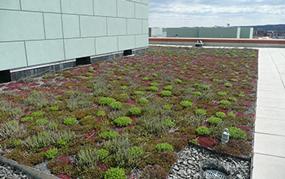Lower Building Energy Demands
 Green infrastructure practices can reduce local temperatures and shade building surfaces:
Green infrastructure practices can reduce local temperatures and shade building surfaces:
- Less energy is required to cool and heat the buildings.
- Emissions from power plants are decreased.
- Cost savings can be realized over time.
How does it work? Trees and vegetative cover can lower ambient air temperatures in urban areas through shading, windbreak, and evapotranspiration. The result is lower demand for the energy needed to provide air conditioning in summer months. Green roofs can greatly reduce the amount of energy (PDF)(11 pp, 401 MB, About PDF) Exit needed to keep the temperature of a building comfortable year-round by insulating against extensive heat loss in the winter and heat absorption in the summer.
A study published by the National Research Council of Canada found that an extensive green roof reduced daily energy demand for air conditioning in summer months by over 75 percent.
On this page:
This page contains technical information and references for state and local government officials working in the field of stormwater management.
How To
Lower Building Energy Demands:
- Make trees business as usual in your community.
- Plant trees in or around stormwater control features like curbside planters and bioswales to amplify the cooling and shading capability of spaces already dedicated to water quality.
- Include tree planting as part of regular capital improvement projects (e.g., street upgrades or road maintenance).
- Partner with tree-focused nonprofits to encourage residential or street-tree volunteer planting or canopy mapping events.
- Provide residents with access to tools and resources to use to plant trees for maximum energy efficiency.
- Studies by the Lawrence Berkeley National Laboratory and the Sacramento Municipal Utility District planted trees around houses at various orientations to evaluate effects on residential air conditioning and heating use. While cooling energy savings ranged between 7 and 47 percent, heat reduction gains were greatest for trees planted to the west and southwest of buildings.
- Incentivize green roof construction.
- Implement private development incentives to encourage community investment in green roofs. The Ecoroof Program in Portland, Oregon, reimburses private property owners $5 per square foot of green roof created. It also provides resources and technical assistance to small businesses interested in entering the green roof industry
- Estimate cooling and energy efficiency benefits.
- You can use publicly available tools (e.g., the U.S. Forest Service’s (USFS’s) iTree modeling suite). The Mid-America Regional Council (MARC) partnered with USFS to quantify multiple benefits from existing tree canopy in the Kansas City, Missouri area. They used iTree to map existing canopy concentrations in the region and estimate the value of building energy efficiency gains. See: U.S. Forest Service iTree Models Exit
Resources
AVoided Emissions and geneRation Tool (AVERT)—Developed by EPA’s Office of Air and Radiation to help estimate the emissions benefits of energy efficiency and renewable energy policies and programs.
iTree Exit —A USFS analysis tool for urban forest managers that uses tree inventory data to quantify the dollar value of annual environmental benefits (e.g., energy conservation, air quality improvement, carbon dioxide reduction, stormwater control, and property value increase).
Green Roof Energy Calculator Exit —Developed by Green Roofs for Healthy Cities, University of Toronto, and Portland State University to compare the annual energy performance of a building with a green roof and the same building with either a conventional or a highly reflective roof.
Adaptation Database and Planning Tool (ADAPT) Exit—ICLEI's tool to guide local government users through the Five Milestones for Climate Adaptation planning. It is available as part of ICLEI’s Climate Resilient Communities Program.
References
Pandit, R., and D.N. Laband. 2010. A hedonic analysis of the impact of tree shade on summertime residential energy consumption. Arboriculture & Urban Forestry 36(2):73-80.
Huang, J., H. Akbari, and H. Taha. 1990. The Wind-Shielding and Shading Effects of Trees on Residential Heating and Cooling Requirements. ASHRAE Winter Meeting, American Society of Heating, Refrigerating and Air-Conditioning Engineers, Atlanta, Georgia, February 11-14, 1990. Exit.
Liu, K., and B. Baskaran. 2003. Thermal Performance of Green Roofs Through Field Evaluation. National Research Council, Institute for Research in Construction. (PDF)(11 pp, 400 K, About PDF) Exit.
Simpson, J.R., and E.G. McPherson. 1996. Potential of tree shade for reducing residential energy use in California. Journal of Arboriculture 22(1):10–18.
Akbari, H., and S. Konopacki. 2003. Streamlined Energy-Savings Calculations for Heat-Island Reduction Strategies. Final Report. Supported by the U.S. Environmental Protection Agency through the U.S. Department of Energy under Contract No. DE-AC03-76-SF00098.
